Nectanebo II
Nectanebo (Egyptian Nakhthorhebe): last pharaoh of independent Egypt, ruled 359/358-342/341.
Coup
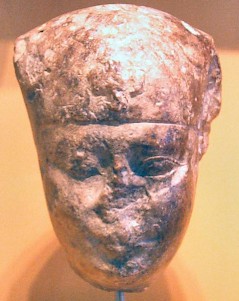
In the fifth century BCE, Egypt had been part of the Achaemenid Empire, but it had regained its independence in 404. In 373, a large-scale attack had been repelled by pharaoh Nectanebo I, and an age of national restoration had began. Nectanebo was succeeded by his son Teos, who launched an offensive against Persia, trying to gain support in Phoenicia (modern Lebanon), the natural target for Egyptian expansion.
Teos set out in the spring of 360, leaving behind his brother Tjahapimu as governor of the country. However, when the expeditionary force had reached Phoenicia, news arrived that Tjahapimu had revolted and had offered the throne to his son Nakhthorhebe or Nectanebo, who was in the army of Teos as commander of the Egyptian soldiers and besieging towns in Syria. According to our (Greek) sources, the cause of the insurrection was discontent among the priests, but one may suspect that in fact the Persian king Artaxerxes II Mnemon had offered money to Tjahapimu and Nectanebo. The Persian policy to divide opponents is well-known from Greece.
Teos was unable to suppress the rebellion. One of his mercenary leaders, the aged king Agesilaus of Sparta, sided with Nectanebo, and the other mercenary leader, Chabrias of Athens, was recalled. Thus ended the expedition; the king fled to Persia, where king Artaxerxes II Mnemon granted him refuge. The reign of pharaoh Nectanebo II could begin (359/358). One of his first acts was a sacrifice to the Apis.
Domestic Policy

One of the first problems Nectanebo had to cope with, was another would-be king at Mendes in the eastern Delta, but the Greek mercenaries of Agesilaus made quick work of him. For the next eighteen years, Nectanebo's power remained unchallenged. He sent back the Spartan king to whom he owed his throne with a bonus of 250 talents, and when the old war horse died in Cyrene, Nectanebo ordered that the corpse would be royally embalmed before it would be sent to Sparta.
The history of the preceding decades had shown that the Persians still regarded Egypt as one of their territories. They had tried to recover it in 385, 383, and 373, and it was likely that one day they would return. Nectanebo used the peace time to built up a new army and employed, as was usual in this age, Greek mercenaries. They demanded pay in silver, and it comes as no surprise to find that Nectanebo's coins resemble Greek coins.

He was also able, like Nectanebo I, to pay for the restoration of old sanctuaries and the construction of new ones. Temples were dedicated to Isis at Philae and to Ammon at Siwa. They may have been intended to obtain the sympathy of the Nubians and Libyans.
First Persian War
The Persians finally arrived in his ninth regnal year, in 351 BCE. Little is known about this campaign, except for the fact that two mercenary leaders, Lamias of Sparta and Diophantes of Athens, dealt with it. The Persian defeat must have been devastating, because king Artaxerxes III Ochus now personally started to build a larger army in Babylon, while a navy was gathered at Sidon, one of the ports of Phoenicia.
Counterattack
Nectanebo knew what was afoot and knew how to intervene. The people of Sidon felt oppressed by the sheer size of Artaxerxes' preparations, and the Egyptian king seems to have told their king Tennes (Phoenician Tabnit) that he would come to their assistance if they rebelled. And so it happened: the Sidonians revolted and Nectanebo duly sent 4,000 Greek mercenaries to Sidon. They were commanded by one of the best Greek generals, Mentor of Rhodes, who had been forced to flee to Egypt after he had joined a failed revolt against the Persians.
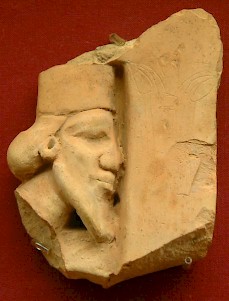
Having lost his navy and not having his army ready yet, Artaxerxes ordered the satrap of Caria, Idrieus, to build ships. The satraps of Cilicia and Syria, Mazaeus and Belesys, had to proceed to the rebellious country and contain the revolt. However, they were repelled by Mentor, and it is possible that the revolt spread to Samaria and Judaea in the south. Meanwhile, other Phoenician towns and the kings of the nine cities on Cyprus had joined the rebels. If Nectanebo was indeed the mastermind behind the insurrection, he had recovered all territories that Egypt had once possessed.
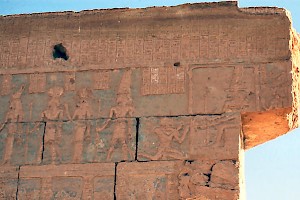
In Greece, the Athenian orator Isocrates was greatly impressed; in a speech he delivered in 347 to Philip II of Macedonia, he said that the success of the rebels showed that Persia was doomed to be destroyed. Few analysts have made greater mistakes, because next year, Artaxerxes arrived at Sidon, and Mazaeus and Belesys joined their king.
The date of his arrival is a bit puzzling, because it means that the rebels were left alone for three years, but probably, the Persians had first reoccupied Judaea, Samaria, and the inner country of Syria. According to the Jewish historian Flavius Josephus, the Persian commander Bagoses (maybe identical to the eunuch Bagoas) entered the Temple, and according to other sources, Jericho was destroyed and Jews were deported to Hyrcania. The apocryphal book Judith contains echoes of this campaign.

Having brought Syria and Judaea to rest, Artaxerxes was ready to attack Sidon in 346 - earlier dates are less likely - and king Tennes and Mentor decided to betray their city. The Persian king received them, ordered the execution of Tennes, but spared Mentor. After all, a Greek mercenary could be useful. Meanwhile, desperate Sidonians set fire to their city. Others were taken captive and arrived in Babylon in October 345. Perhaps a year later, Cyprus surrendered.
Second Persian War
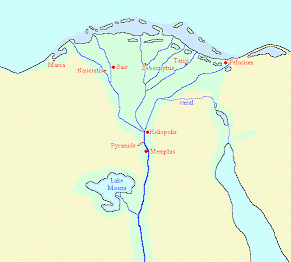
Egypt was now dangerously exposed to an enemy attack. It had lost Phoenicia and Cyprus, which were excellent bases for the navy that the Persians needed (for support during the crossing of the Sinai desert). In the last months of 343, after the inundation of the Nile, Artaxerxes arrived, together with his colonels, the above-mentioned eunuch Bagoas and the mercenary general Mentor of Rhodes. (Among the other officers was Orophernes of Cappadocia.) Obviously, the invaders had bribed people in Egypt, because the Greek mercenaries at the garrison of Pelusium in the northeast surrendered. From now on, the invaders had a bridgehead in the kingdom of Nectanebo. Not much later, Bubastis and other fortified cities fell.

The Nile lay now open for the Persian navy, which proceeded to Memphis. Nectanebo had proceeded to that city, because he thought that he could make a stand against the Persians in his capital. This turned out to be a grave error: his soldiers thought that it was a retreat, and were demoralized. Seeing that his position had become hopeless, the last pharaoh of independent Egypt decided to gather his possessions, and fled to Thebes in the south, and hence to Nubia, where he died in 342/341.
Aftermath

This was the end of the last period of Egyptian independence. It had lasted 62 years. According to the Greek sources, which delight in the comparison of Cambyses and Artaxerxes, the second conqueror desecrated several temples and killed the Apis bull, just like the first one had done. There is no reason to believe this; it would have been foolish to antagonize the new subjects. On the other hand, it seems that the Persians did indeed devastate the tomb of pharaoh Nepherites I at Mendes. The Egyptians hated their new masters, and the Persian garrison understood that the native population would side immediately with everyone who would present himself as a liberator.
The Egyptians believed that Nectanebo, who had expanded Egypt to Syria and Cyprus and was not dead yet, would one day return and throw out the Persians. Nine-and-a-half years later, this idea proved more or less true, when the Macedonian conqueror Alexander the Great arrived. The Persians, knowing that their position was hopeless, surrendered immediately, and the Egyptians told stories to each other that Alexander was in fact not the son of Philip of Macedonia, but of Nectanebo. These stories were later inserted in the Alexander romance, a vie romancée of the conqueror.
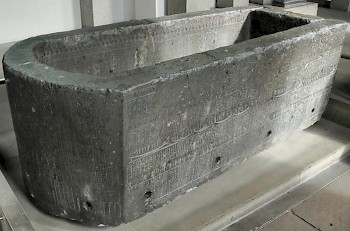
Nectanebo's empty sarcophagus - it was never used because he fled to the south - was said to be discovered by the Egyptian expeditionary force of Napoleon Bonaparte. The object was immediately believed to be the last resting place of Alexander the Great. Therefore, Napoleon sent it to France; according to rumors, he wanted to be buried in the sarcophagus of his hero. However, the British captured the Paris-bound ship in 1801, and the sarcophagus that was meant to be the final resting place of no less than three rulers, now rests in the British Museum.